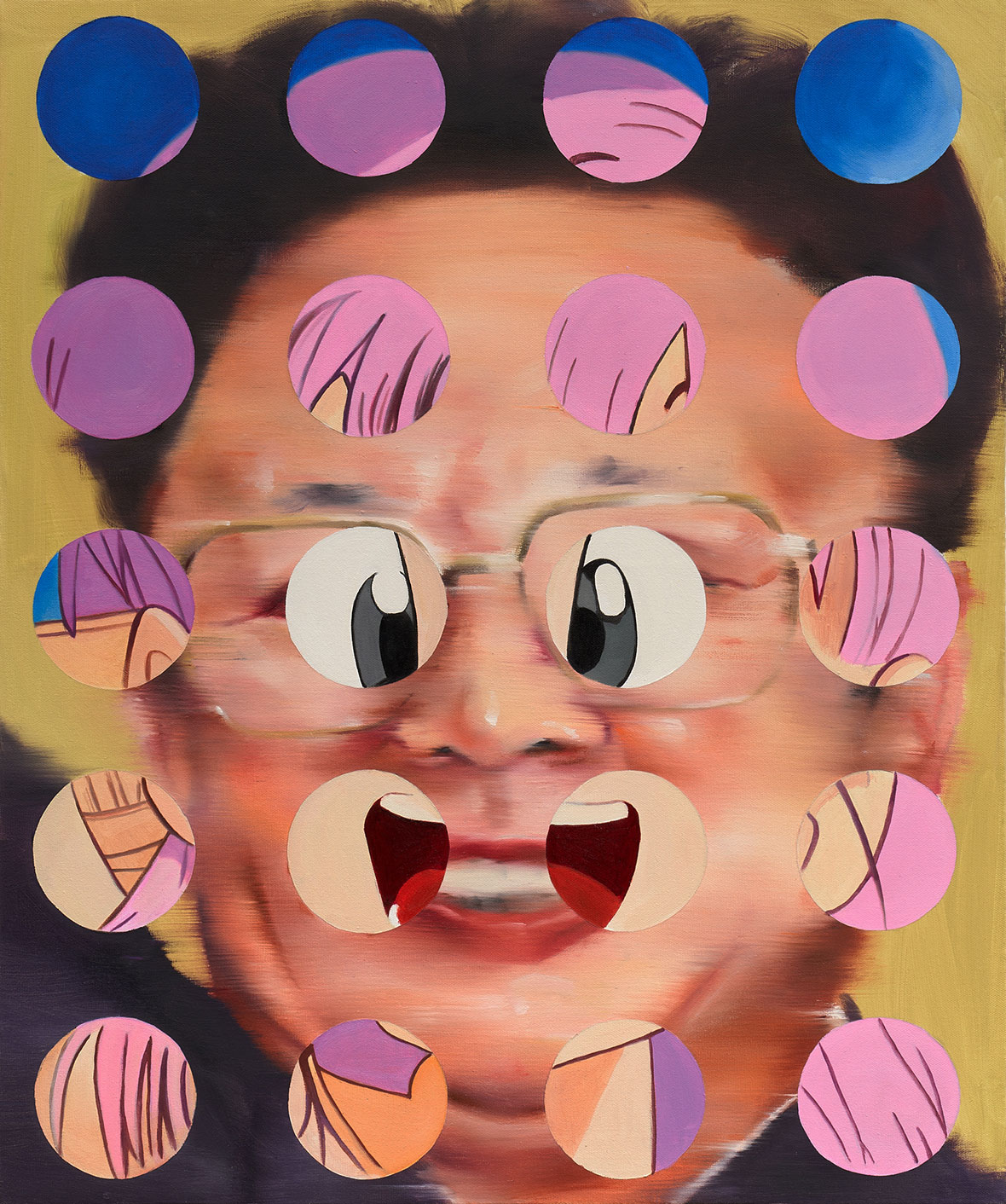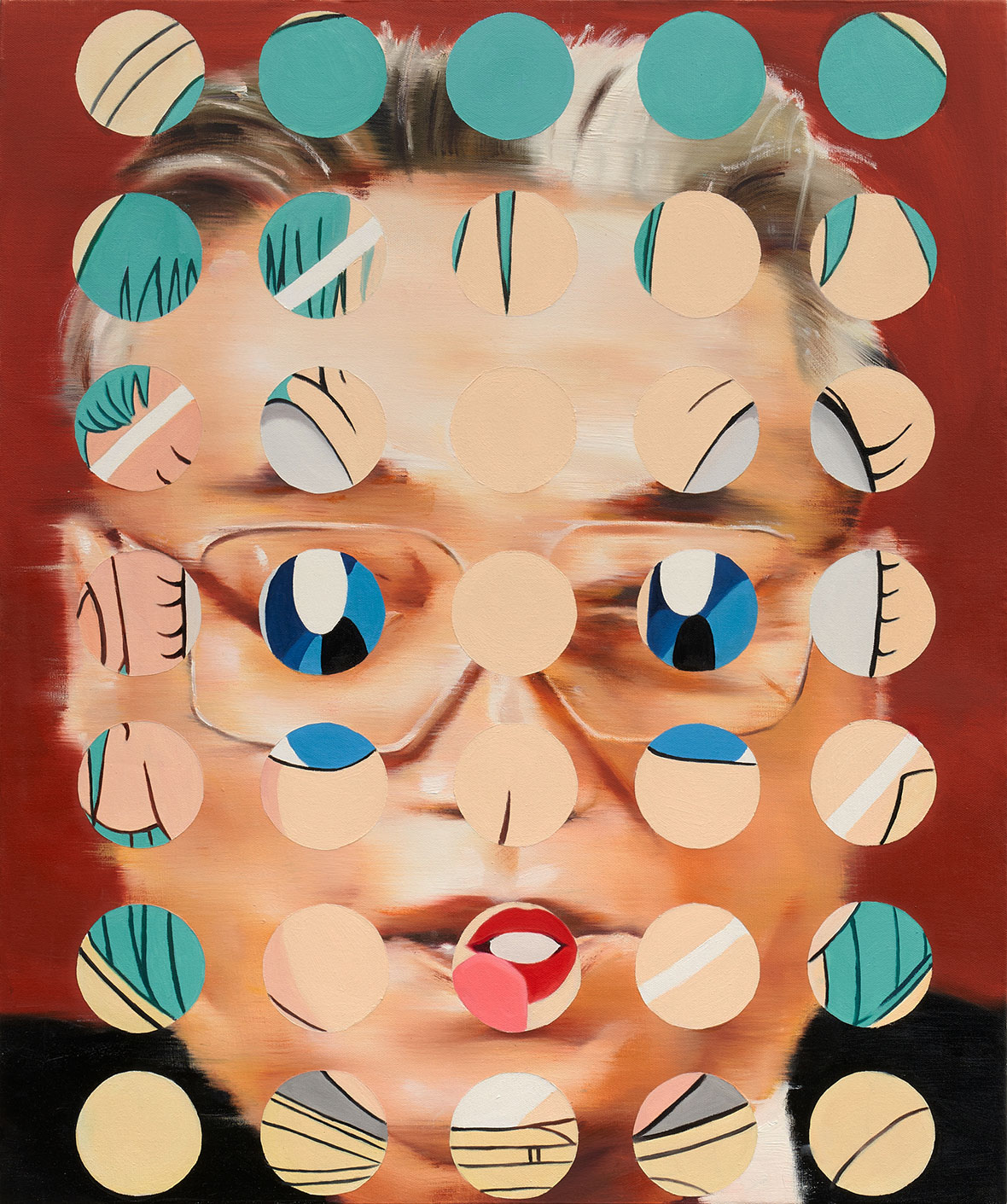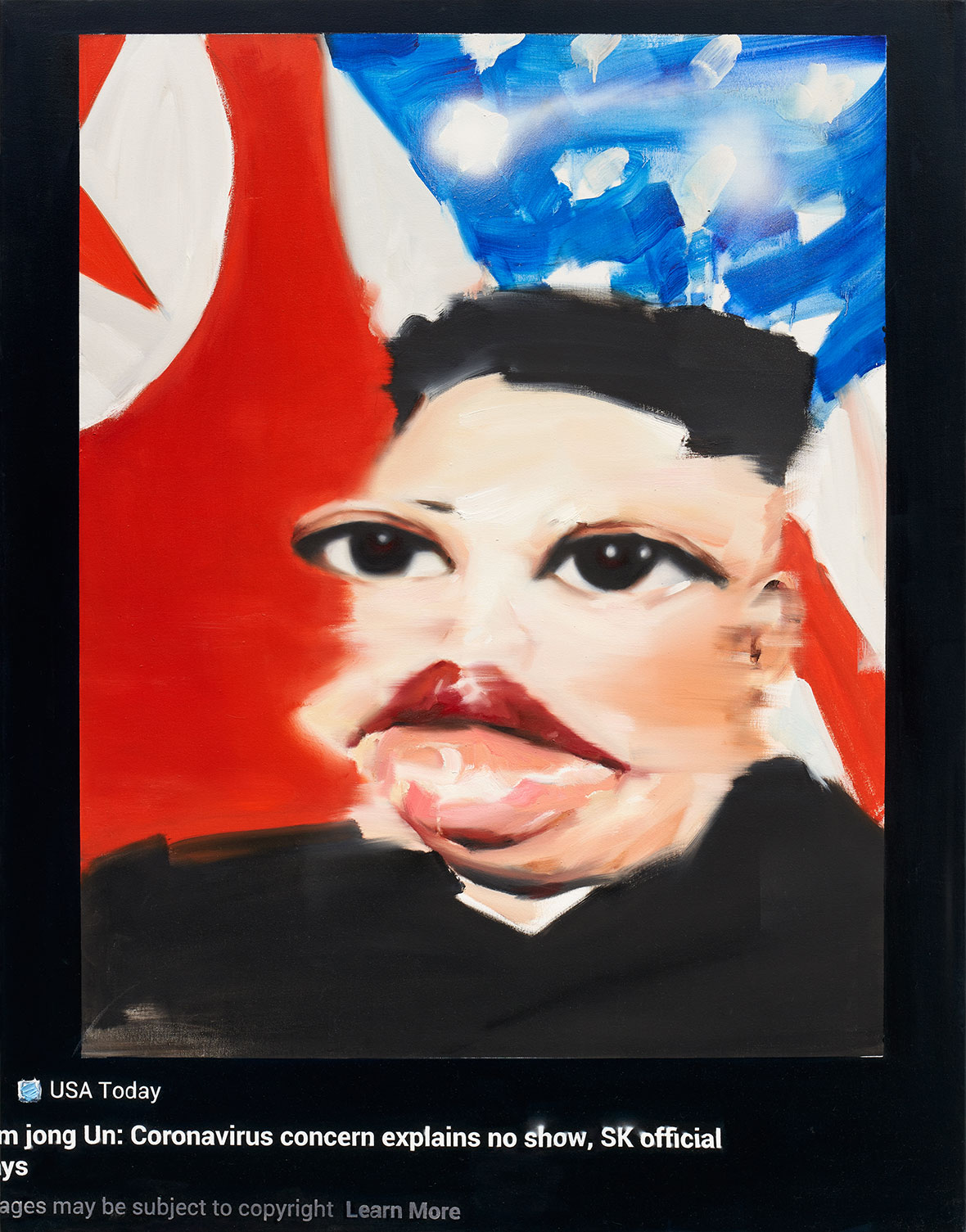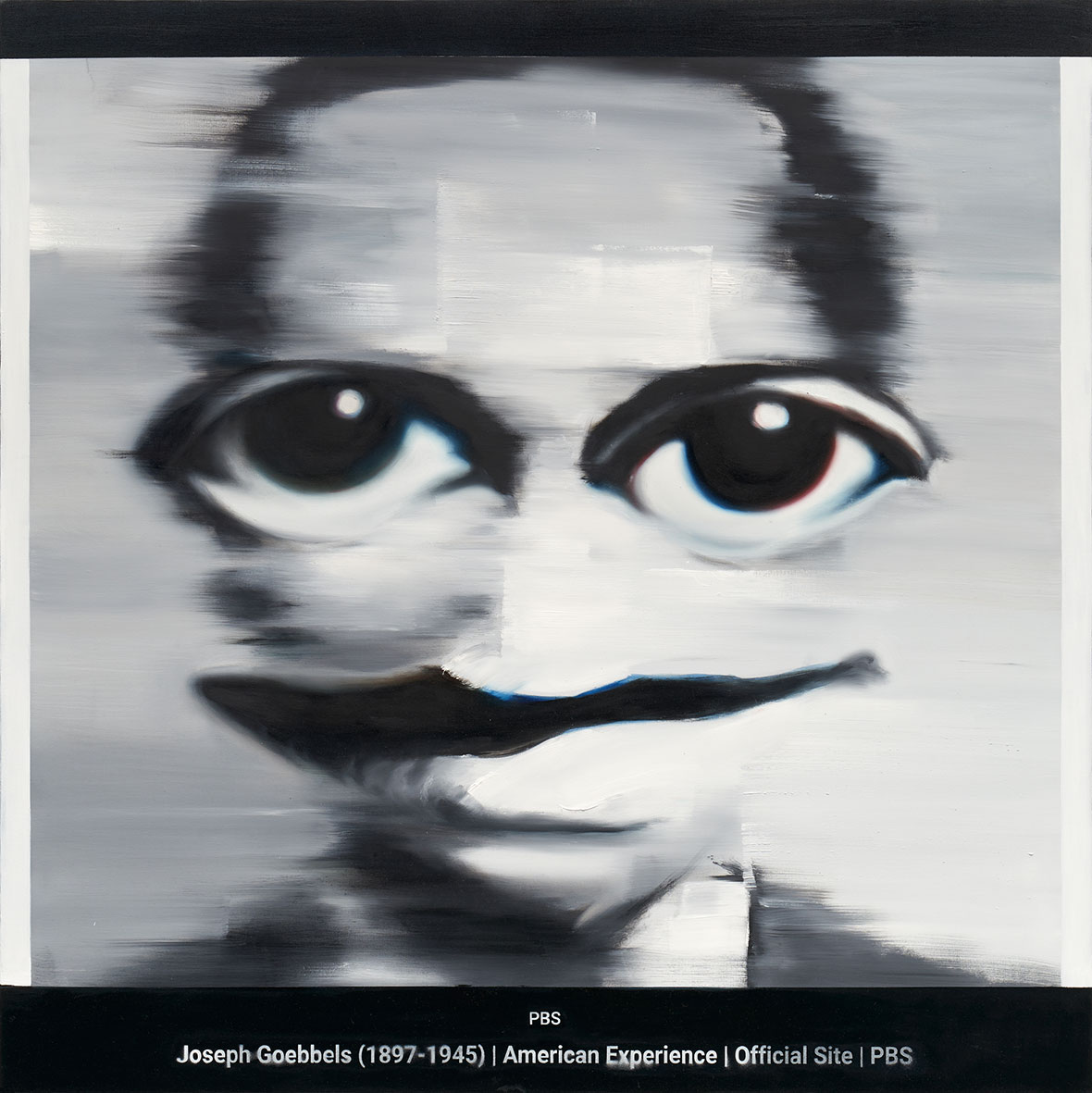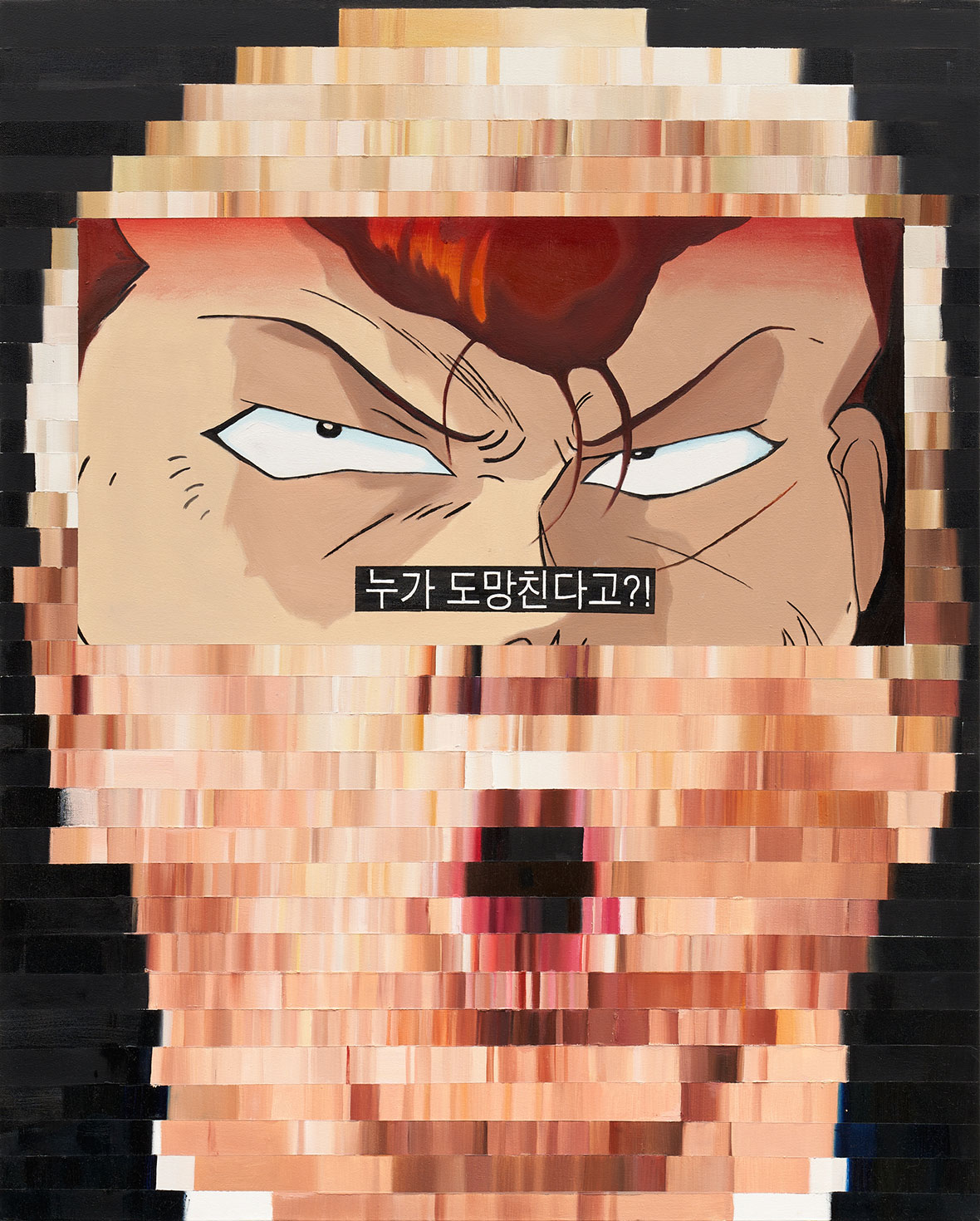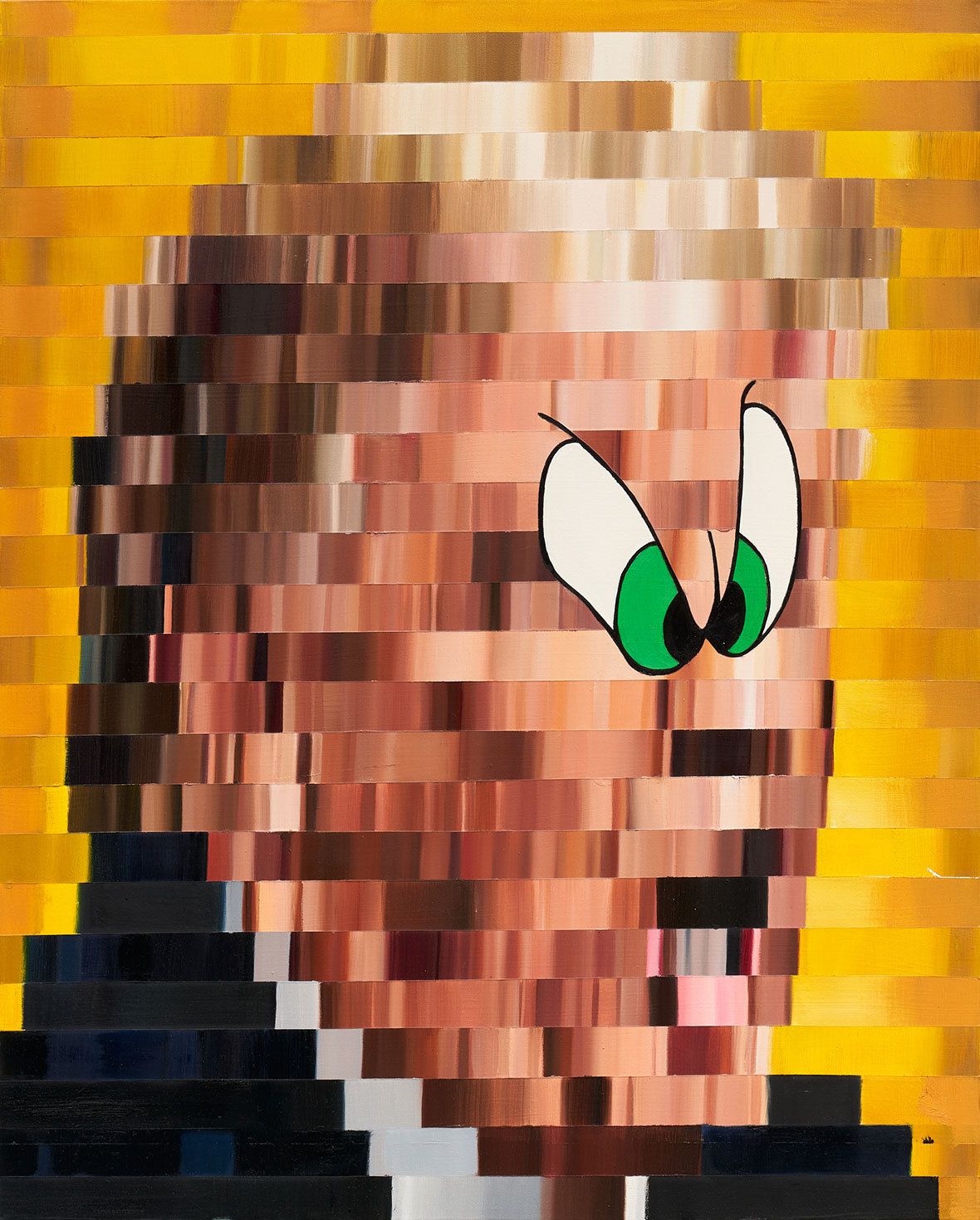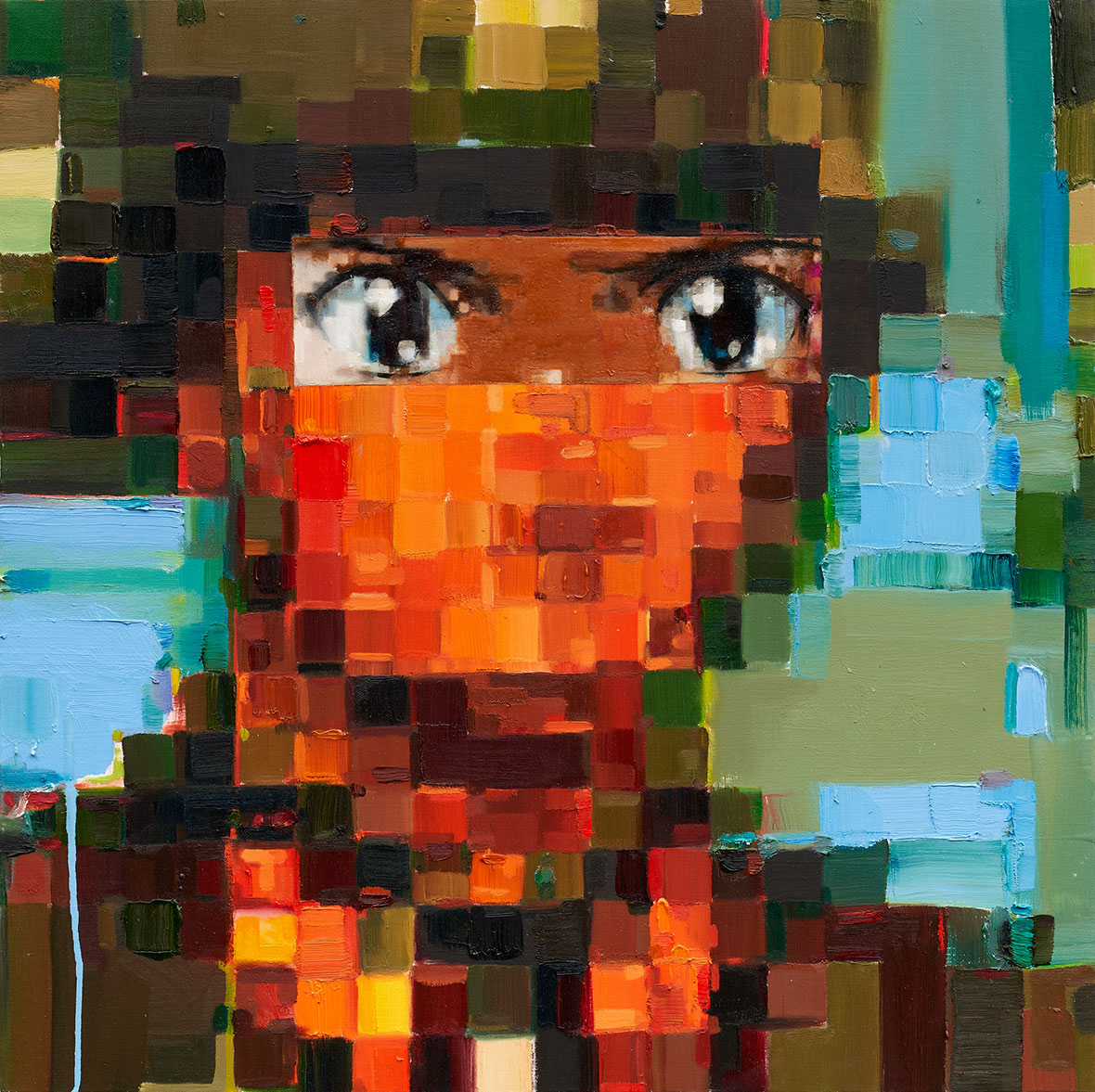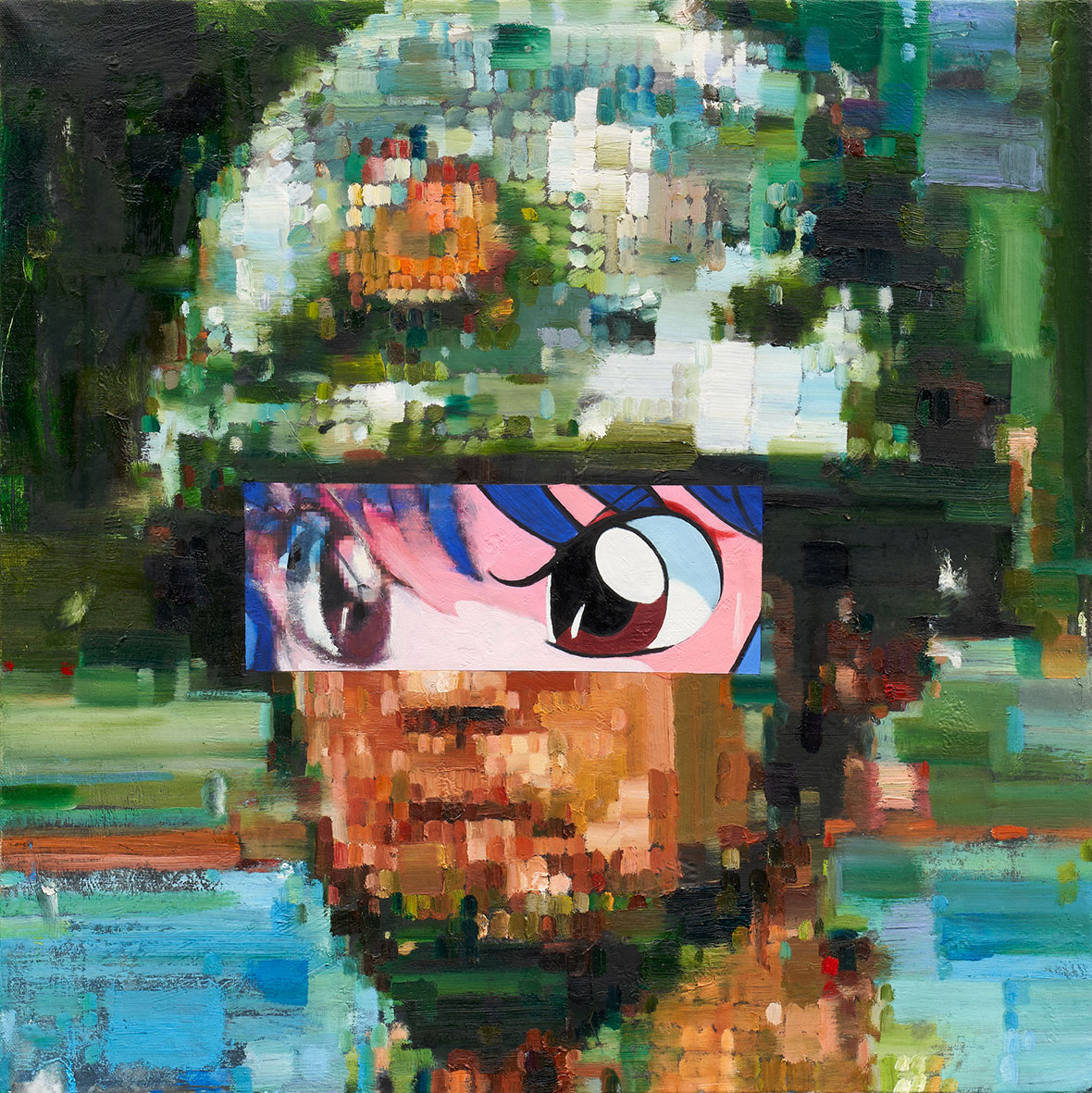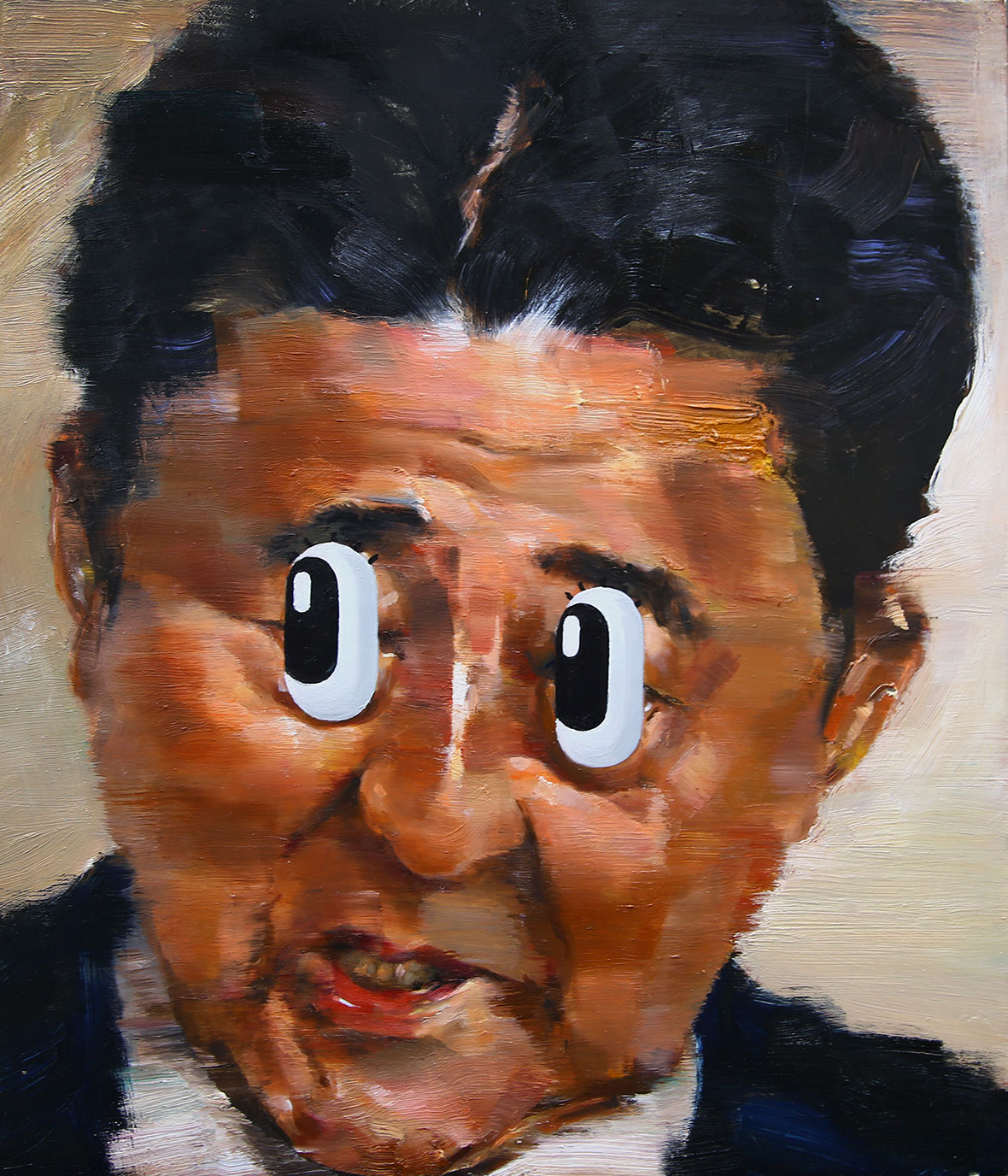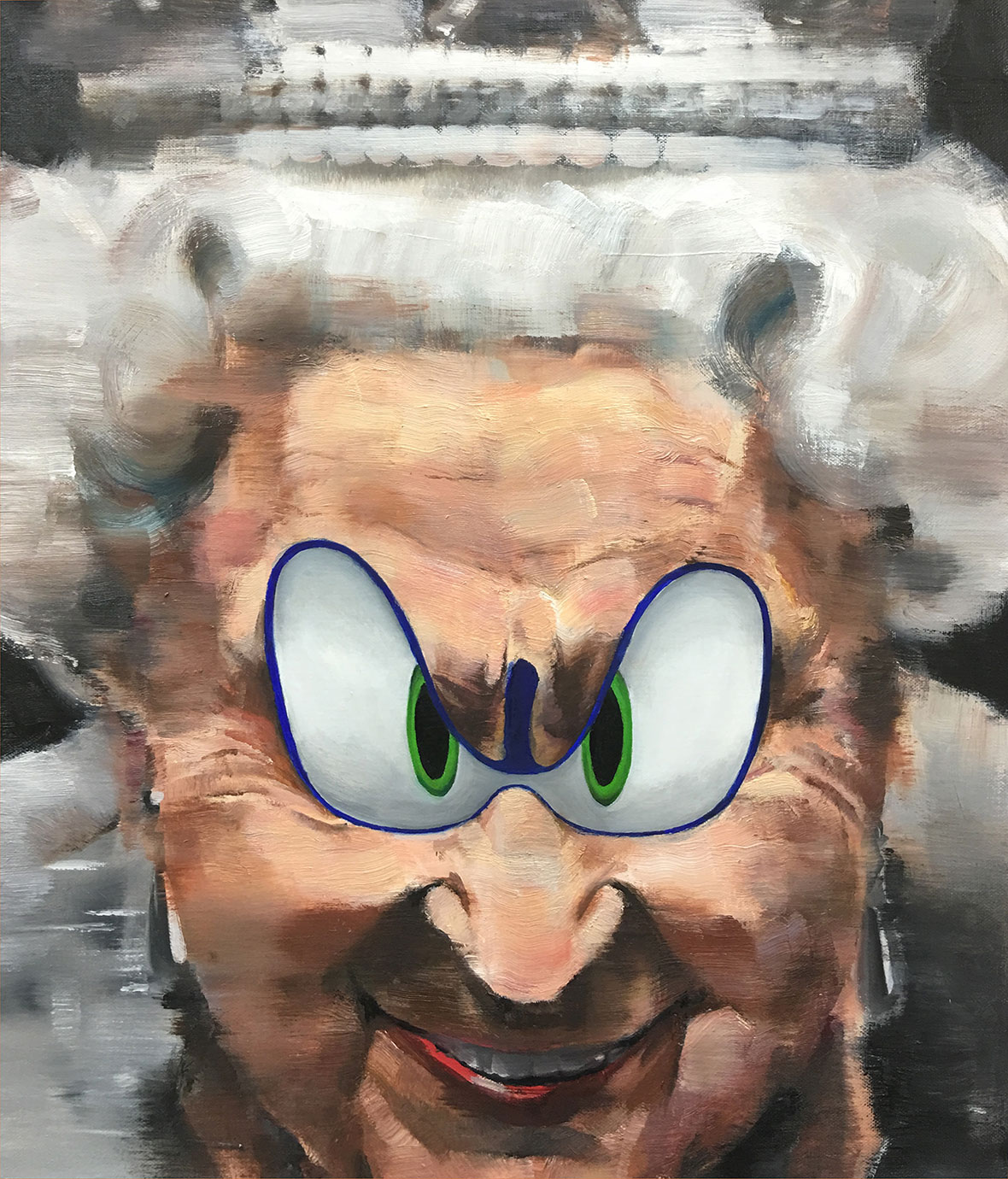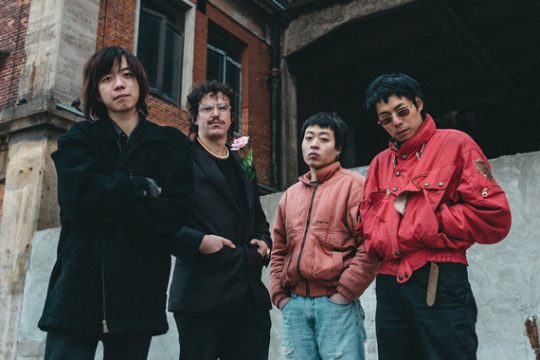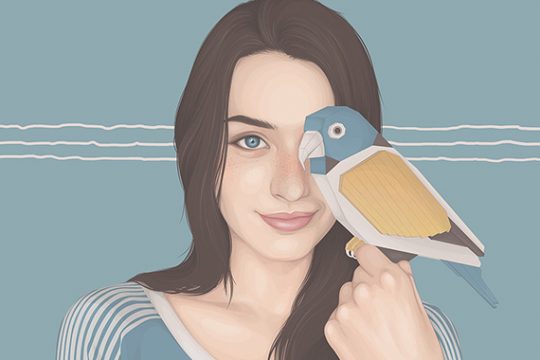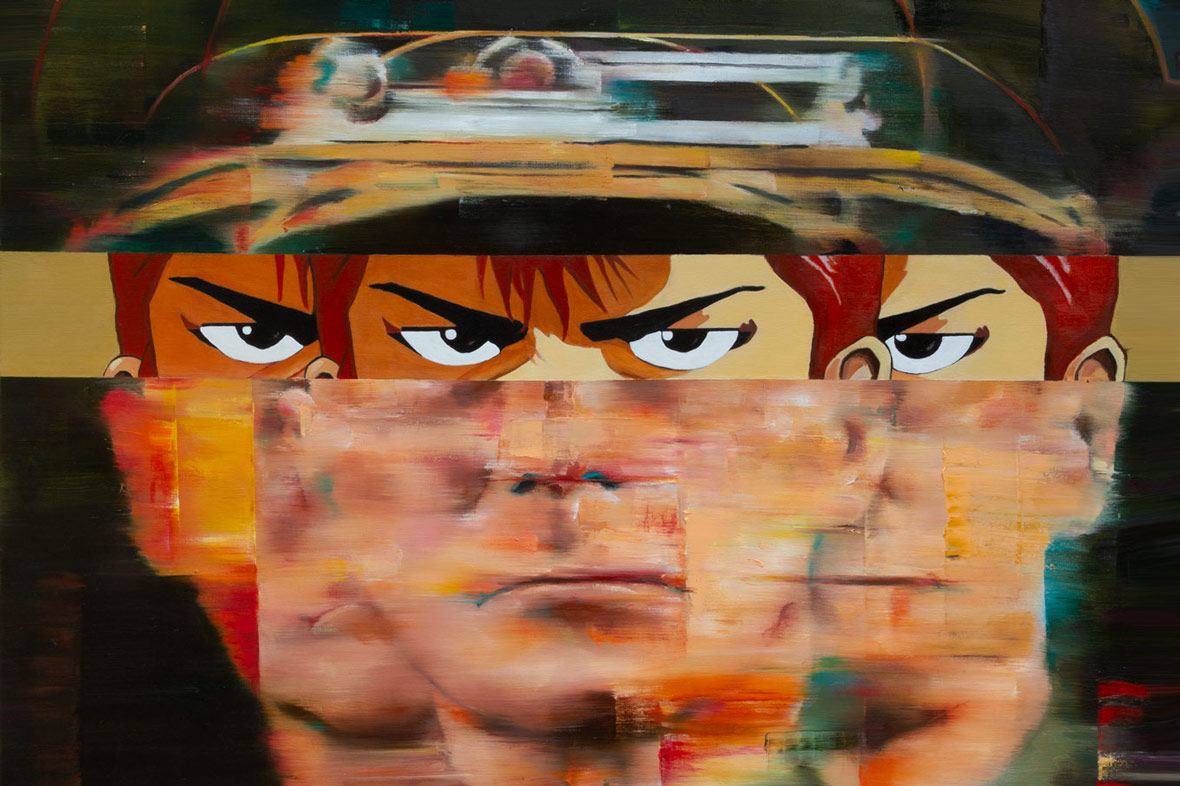
In the age of doomscrolling, we’ve become addicted to endless feeds of incendiary headlines and thumbnails that illustrate the depressing state of the world. The overstimulation of the online realm leaves us utterly dazed, no longer knowing what’s trivial or troubling, real or fake—and no one’s immune.
Born in 1995, as part of Gen Z—the first truly digitally native generation—South Korean artist Jang Seungkeun renders the nonsensical amalgam of the internet into paintings that dish out stinging commentary on how we consume and spread information online. To him, we’re living in a post-truth era of questionable and frenzied content designed to lure undiscriminating audiences. “In the present era, narratives collapse, and the truth is lost, dominated by thumbnail images,” he says. “My work contemplates the uncontrollable anxiety in this idling world.”
Jang’s art revolves around montages of clashing images reclaimed from the internet. It features global personalities from pop culture, history, and present-day politics, as well as other figures that take center stage in various episodes of media frenzy. His portraits, however, are never flattering; they always come with an edgy, playful twist.
这是一个被负面刷屏的时代,我们沉溺于揭示世间煽动性标题和简报。网络空间的过度刺激令我们茫然无措,大事小情、真真假假变得难以分辨 —— 没人能够幸免。
韩国画家 Jang Seungkeun 生于 1995 年。作为 Z 世代,他属于第一批互联网时代的亲历者。他把网络上光怪陆离的元素挥洒在画布上,对消费和网络信息传播进行了针砭时弊的批判。在他看来,我们所生活的后真相时代普遍存在真相质疑的现象,导致那些缺乏辨别能力的人因此沦陷,从而达到背后操纵者的目的。“当下,文字崩坏,真相缺失,取而代之的是残缺信息碎片。我的作品对乱世引发的焦虑情绪进行了深刻反思。”
Jang 的作品由互联网新闻图片构成,涉及一众名人:流行文化大咖、传奇历史人物、政客以及曾红极一时的风云人物等等。然而,他笔下的人像并没有谄媚之颜,反而在旁人眼里充满了戏谑、直击要害的暗讽意味。
In the series Source, Jang paints some famous—and some infamous—politicians from around the world, but with an added layer of silliness. Joe Biden, Kim Jong-un, Donald Trump, John Kennedy, and Joseph Goebbels appear with exaggerated features we’re all too familiar with: the big eyes and wide mouths typical of popular Instagram and Snapchat filters. “The faces of influential people whose actions affect everyone’s lives appear just like the faces of netizens when they use these filters, and the result is both hilarious and scary,” Jang says.
For this series, Jang googled the subjects he was interested in and captured the image results with the filter app on his phone. Then, he transposed the results onto canvases using oil painting. “I wanted them to look like sports cards or monster images from Yu-Gi-Oh!,“ he laughs, referring to Kazuki Takahashi’s manga series about a trading card game. Not coincidentally, like a trading game on a global scale, the people he portrays are the ones consistently involved in global conflicts and power disputes.
Interestingly, Jang reveals the source of his references in the title of each work, and he includes other elements like page titles and headings in the paintings, offering further clues to finding these images online. The viewer can easily trace his steps, apply the filter to a web search result, and get the same effect on the same faces.
在《追踪》(Source)中,他描绘了一系列政治人物,当中不乏一些闻名遐迩的角色,另一些人则臭名在外,视觉呈现令人忍俊不禁。乔·拜登、金正恩、唐纳德·特朗普、约翰·肯尼迪和约瑟夫·戈培尔的形象跃然纸上,拥有大众喜闻乐见的漫画式幽默:人物眼镜和嘴巴被放大,与 Instagram 和 Snapchat 的流行滤镜效果如出一辙。“加上滤镜后,人物显得更加亲近,狰狞且好笑”,Jang 说道。
创作过程中,Jang 经常在谷歌上搜索新闻热点,并对其进行截图,随后用手机滤镜加以修饰,以此激发创作灵感。在谈及引用高桥和希的集换式卡牌游戏漫画风格时,他笑道:“我希望我笔下的人物看起来和《游戏王》卡牌上的怪兽一样,不同人物有各自的技能。”而现实与游戏类似,我们正身处由少数人掌握的游戏之中,Jang 笔下的人物在全球冲突和力量博弈之中颠簸沉浮。
每幅作品的网页信息来源巧妙地出现在作品下方,予人们线索,观众可轻而易举地追踪到新闻来源,从而更好地理解作品。
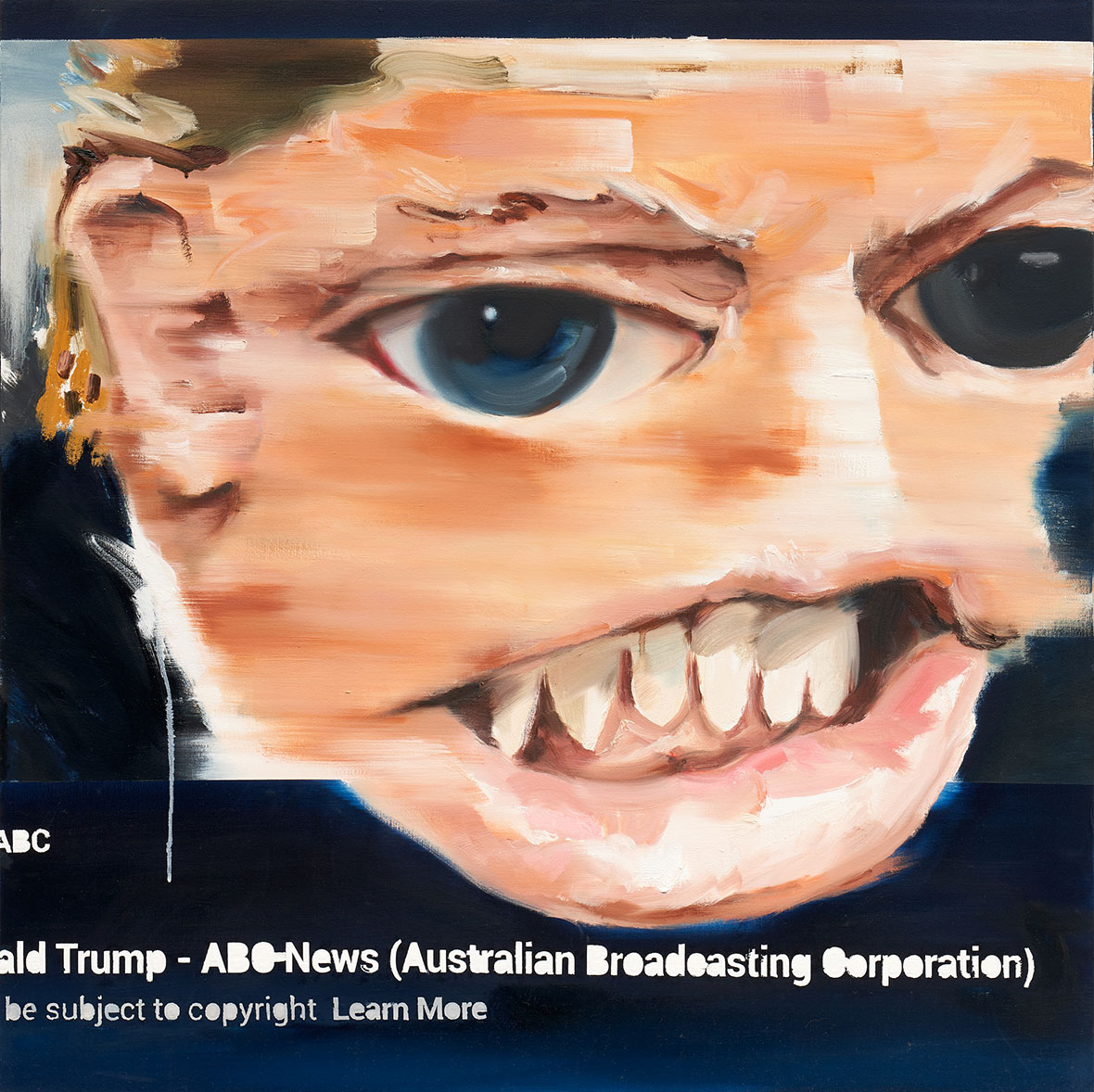
In a separate series, Jang paints his larger-than-life personalities with pixelated, blurred, or glitchy faces, as if seen on low-resolution. Then, he replaces their eyes with the eyes of TV cartoons and anime characters which, in turn, appear clear, in high-resolution style.
People in the likes of Hitchcock, Marilyn Monroe, Beethoven, Shinzo Abe, Moon Jae-in, Stalin, Queen Elizabeth II, Obama, and even Bin Laden, to name a few, are matched with the eyes of other equally renowned characters, like Garfield, SpongeBob SquarePants, Squidward Tentacles, The Powerpuff Girls, and Pink Panther. Aside from Western cartoons, Jang also incorporates eyes from Japanese anime characters, such as Yusuke Urameshi from YuYu Hakusho, Ken Washio from Science Ninja Team Gatchaman, and Shinji Ikari from Neon Genesis Evangelion.
在另一组系列中,人物轮廓在马赛克效果的加持下变得模糊不清。而在这朦胧之中,人物却拥有像电视卡通或动漫人物一样被夸张放大的双眼。
希区柯克、玛丽莲·梦露、贝多芬、安倍晋三、文在寅、斯大林、伊丽莎白二世、奥巴马和本·拉登等人的双眼,纷纷被加菲猫、海绵宝宝、章鱼沃德、飞天小女警和粉红豹等一众卡通人物的双眸取代。除了西方动画,《幽游白书》(YuYu Hakusho)中的浦饭幽助、《科学小飞侠》(Science Ninja Team Gatchaman)中的肯·鹫尾以及《新世纪福音战士》(Neon Genesis Evangelion)中的碇真嗣等日本动漫人物的眼睛都出现在作品当中。
In planning his odd compositions, he downloads images from the internet and experiments in Photoshop. He ultimately chooses the most eccentric results to paint it on canvas. “There are no criteria for choosing them,” he shrugs. “Sometimes there’s a relationship between the character’s personality and the real person, but that’s only a secondary element, for fun.” Jang cherishes the ambiguous nature of his paintings, which invites viewers to create unique narratives and imagine connections. This implicit subjectivity is the essence of his work.
Anything viral is grist to his mill. Jang likes to turn the hype of social media challenges into art. In the Assemble series, he draws inspiration from the Ice Bucket Challenge. Once more, his original references are a simple Google search away, including the first image that appears on Wikipedia when we look up the challenge (the online encyclopedia is a major source of inspiration to him), and a picture from when George W. Bush took the challenge.
Another trend that didn’t escape his brushes was the Sailor Moon Challenge, which encouraged artists to redraw the world-famous anime character in their own distinctive style. Jang’s version, Demo, features the show protagonist’s blue glaring eyes superimposed on Joe Biden’s face. This piece was also inspired by how the outcomes of American elections affect social feelings of optimism and anxiety across the world in South Korea.
在对这样令人意想不到的组合进行构思时,Jang 先会采用 Photoshop 对不同图片进行组合试验,最终选出最为怪诞不经的组合进行创作。“我的选择没什么标准”,Jang 耸耸肩说道,“有时,动画人物和真实人物的性格会有一定联系,但这只是次要因素。我主要还是为了好玩。” 除此之外,作品中的朦胧感被 Jang 视作重点。若虚若实的效果在某种程度上唤起观众的联想,而这种含蓄性、隐晦性正是作品的精髓所在。
任何风靡一时的元素都能为 Jang 带来创作上的灵感。他热衷于将社交媒体中的噱头用艺术的手段表现出来。在冰桶挑战的启发下,Jang 创作了《拼装》(Assemble)系列 。该系列的灵感来源于谷歌搜索结果,其中包括维基百科冰桶挑战词条下的第一张图片(维基百科是他灵感的主要来源)以及小布什接受挑战时留下的一张照片。
此外,Jang 还用美少女战士挑战赛暗示总统局选举。在这张名为《小试牛刀》(Demo)的作品中。水冰月的蓝色大眼被挂在乔·拜登脸上,反映出美国总统选举结果对韩国民众心理产生的种种影响,有些人心生希望,另一些人则对此心神不宁。
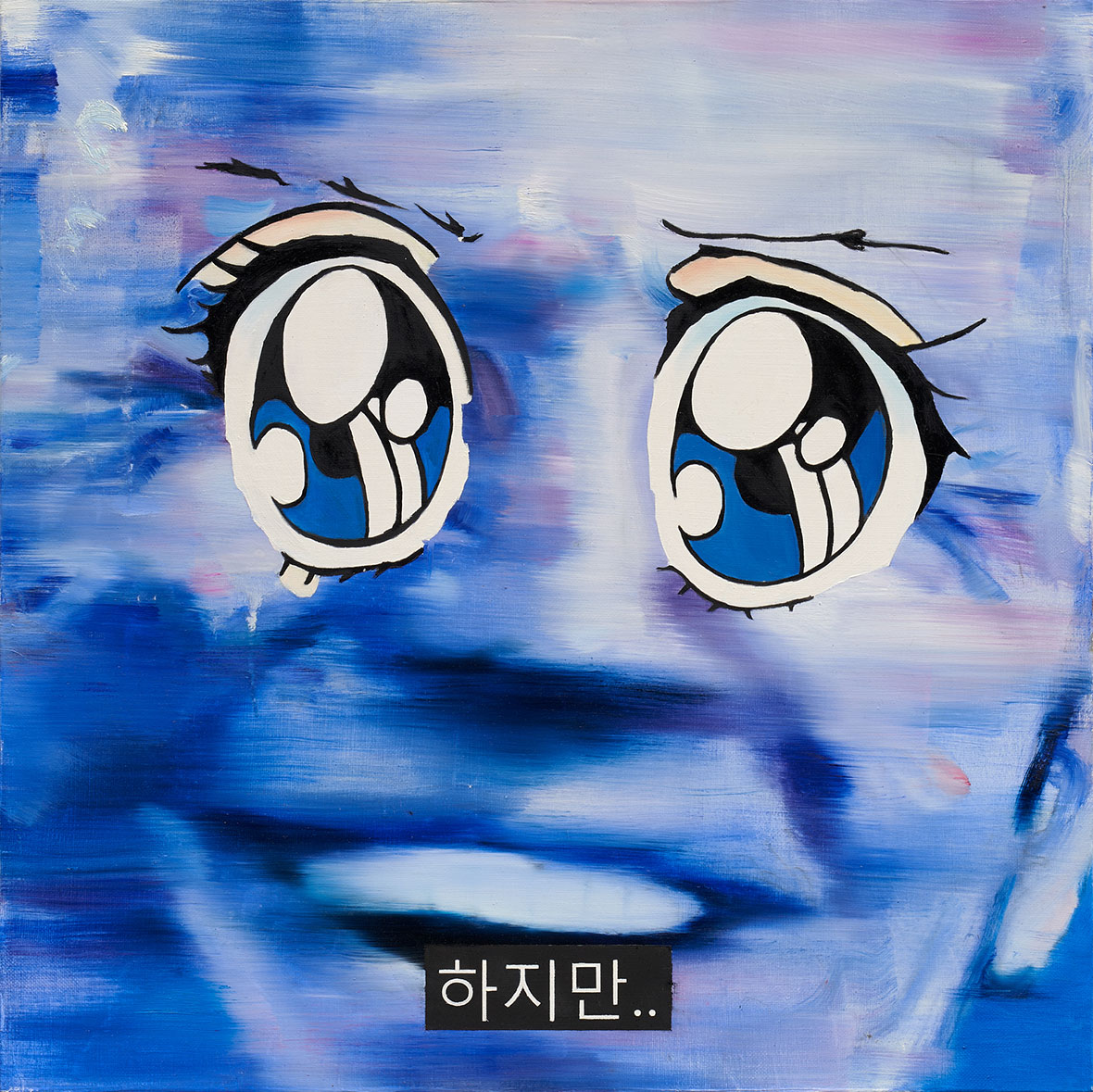
Donald Trump—who has long been a source of memes, clickbait headlines, and internet virality like no one else—is a recurring character in Jang’s work. In the paintings that feature him, his mannerisms and expressions are obvious even if his face appears pixelated. The whole phenomenon concerning Trump’s magnetism on the internet and his association with internet memes fascinates Jang. “Memes help you to unite with others and express your points of view in a comic way. By saying it’s just a joke you sort of neutralize the critical view. I don’t think the relationship between the meme Pepe the frog and Donald Trump’s presidential success is a mere coincidence,” he says, alluding to the theory that the controversial frog meme might have had a favorable impact on Trump’s election.
唐纳德·特朗普(Donald Trump)是网络热梗的重要素材,他为互联网创作者提供了极佳的机会,往往火爆全网。Jang 也常常邀请他到作品中做客。他笑着说道:“网络热梗增近名人和大众的距离,这种幽默搞笑的表达方式能使批判变得不再那么尖锐。”

Jang’s creative process differs slightly in Moe Soldier, a set of two paintings based on images of North Korean soldiers. To shine a light on the question of what’s real and what’s not, he experimented with a new technique: mixing digital print and oil painting. Once more, he juxtaposes anime eyes with pixelated faces. However, this time he printed the anime cuts, already pixelated, glued them to the canvases, and painted over them, leaving small sections exposed. The lines between the parts are positively blurred; only an attentive eye can distinguish between his brushstrokes and the print, even from up close.
As Jang explains, South Koreans are used to seeing caricatures of the North Korean military appearing on local media channels. “Those who threaten us flow around the web as memes and comical figures,” he says, adding that these portrayals often blur the difference between the trivial and the consequential, making it difficult to see the truth about a particular issue. Similarly, the title of the series explores the disparity between the hostile figure of a soldier and the vulnerable, candy-coated notions of moe, a subgenre of anime that explores the idea of inocent and fragile femininity.
Jang 还根据朝鲜士兵形象创作的双联画《萌战士》(Moe Soldier)系列。相比以往,该系列的创作过程稍有不同。为了突出虚实与真假的对比,Jang 尝试了不同以往的创作方式:将数字打印与油画相结合。这次,他将打印好的像素化动漫剪贴画贴到画布上,再用画笔创作,实现了一次油画和数码打印的融合。两部分之间的线条被有意识地模糊,需细致观察才能辨出手绘与打印的差别。
Jang 解释,对于韩国人来说,社交媒体上出现的朝鲜军人形象早已习以为常。他表示,每次看到这些军人的照片,都令人感到迫在眉梢。现实网络中,他们的形象通常以表情包或搞笑图片等形式流传。他还认为,作品中刻意营造的模糊感,隐喻了扑朔迷离的国际形势。此外,这一系列作品通过软妹的双眸与士兵肖像进行对比,探索了二者间的巨大差别,引人深思。
Above all, Jang is drawn to cynical and catchy humor, which he defines as kitschy. “I think kitschy jokes symbolize a sense of defeat. They are twisted expressions of disgust for a society where it’s difficult to have healthy dreams and hopes,” he says. In Kitsch Man, he combines the faces of the supreme leaders of North Korea with female anime characters. For instance, in one piece, he juxtaposes Kim Jong-un with Bulma from Dragon Ball Z, who’s pretty, spoiled, and vain, often using her looks as an excuse for her selfish attitude. These pieces bear a sense of heightened visual confusion through evenly distributed overlaid dots, a result Jang achieved from experimenting with clipping masks in Photoshop.
The idea stems from Roy Lichtenstein’s Ben-day dots and his use of comics to convey his message. “I like the message behind his sarcastic work and his choice of using subcultures as something with aesthetic value,” Jang says. Pop art has influenced him since his early days as an artist. He began painting the faces of pop icons still in university as an homage to Andy Warhol.
总的来说,Jang 的绘画主要围绕政治幽默展开,以此来表达普罗大众对现实的不满情绪,他个人将这种创作方式称之为 “低俗创作“。他说道:“我的作品像是一个个庸俗的笑话,体现出一种挫败感,反映了人们对现实的厌恶。这是一种扭曲的表达方式”,Jang 如是说。在系列作品《俗咖》(Kitsch Man)中,他将金日成肖像和日漫女性角色进行叠加;还将金正日和《七龙珠》中面容姣好的自负女孩布尔玛(Bulma)进行联动,漫画中,布尔玛时常凭借靓丽外表做着自私的事。画面上均匀分布的波点迷乱了观众的视线,Jang 采用了 Photoshop 中的剪贴蒙版功能来实现这一效果。
画中引用的波点,其灵感来源于波普艺术大师罗伊·利希滕斯坦(Roy Lichtenstein)标志性的大圆点(Benday dots)。Jang 表示,“罗伊对时代的批判使我着迷,他对非主流文化也情有独钟,并将其拔到了一个新的高度。”在绘画生涯初期,Jang 受波普艺术的影响很大,为了致敬安迪·沃霍尔(Andy Warho),他曾在大学期间就开始试着描绘名人肖像画,这为他之后的创作埋下了一颗种子。
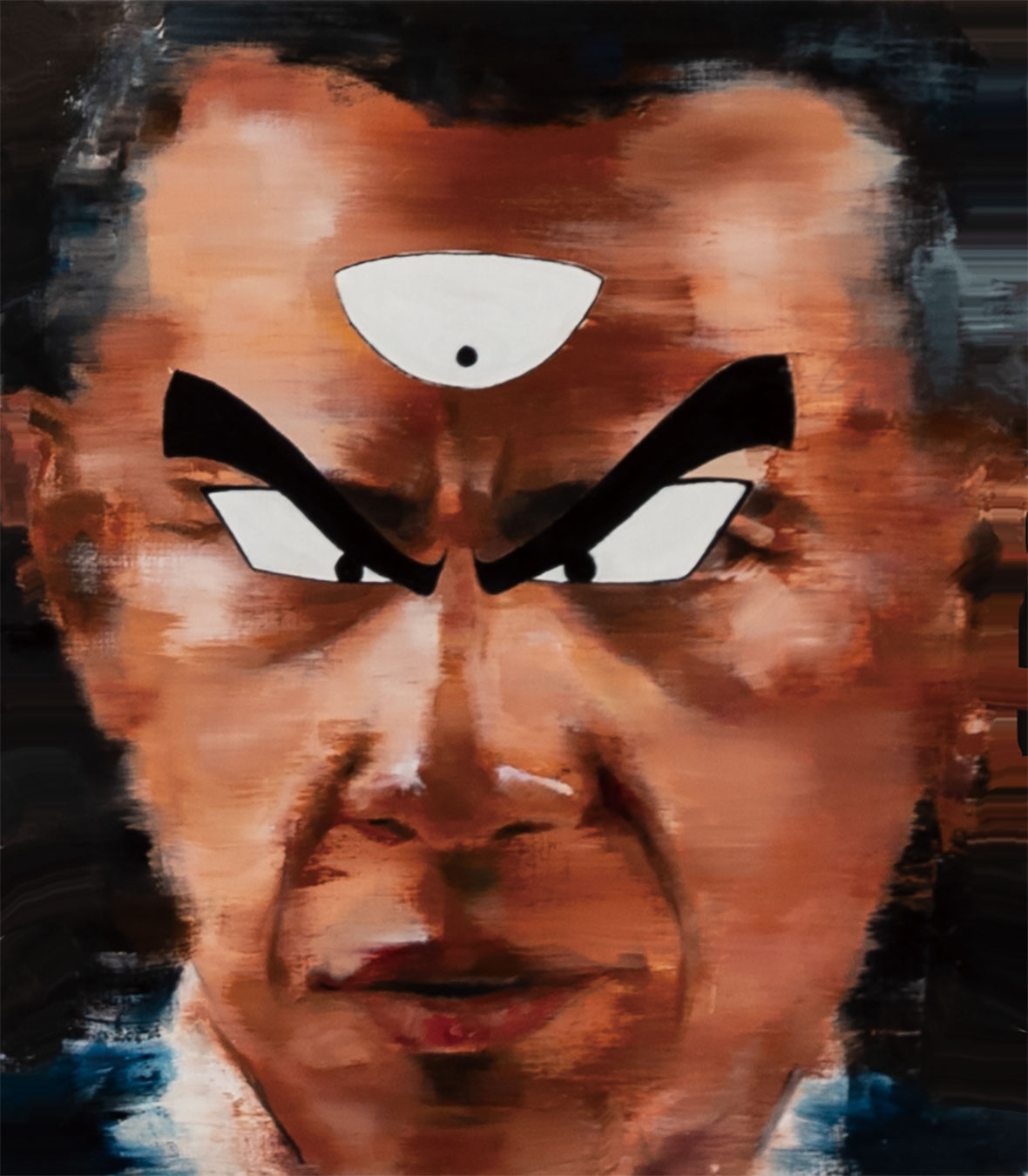
Even if Jang uses the cultural scope above as a reference, his inspiration comes primarily from his own experiences—particularly those he considers unpleasant. For instance, he forced himself to get familiarized with certain anime and Netflix shows only to have something in common to talk about with other people in his social circle. “I needed to know about these shows not to look like an out-of-date artist, but I didn’t have the time or will to watch them,” he admits.
His solution was to get the gist of what he needed from reading Wikipedia articles and watching YouTube summary videos. He even began acting as a fake otaku, something he thought was comical, to say the least, but that also illustrated more significant issues in modern society, such as the widespread inversion of values and the lack of depth.
现如今,Jang 的创作灵感主要源自他于网络的所见所闻,尤其是那些令人百感交集和迷惑的瞬间。为了在作品中寻求与他人的共鸣,他强迫自己去看某些日漫和网飞节目。他承认:“为了跟上时代的步伐,我必须熟悉现在媒体的流行趋势,但我依然觉得兴趣寡淡,也没有很多时间。”
对此,他想到了一个解决方法:阅读维基百科首页内容、观看 YouTube 上国际新闻汇总。为了熟悉漫画角色,他甚至一度成为御宅。在这个过程中,他渐渐发现现代社会的特征 —— 价值观的颠覆以及深度的匮乏。
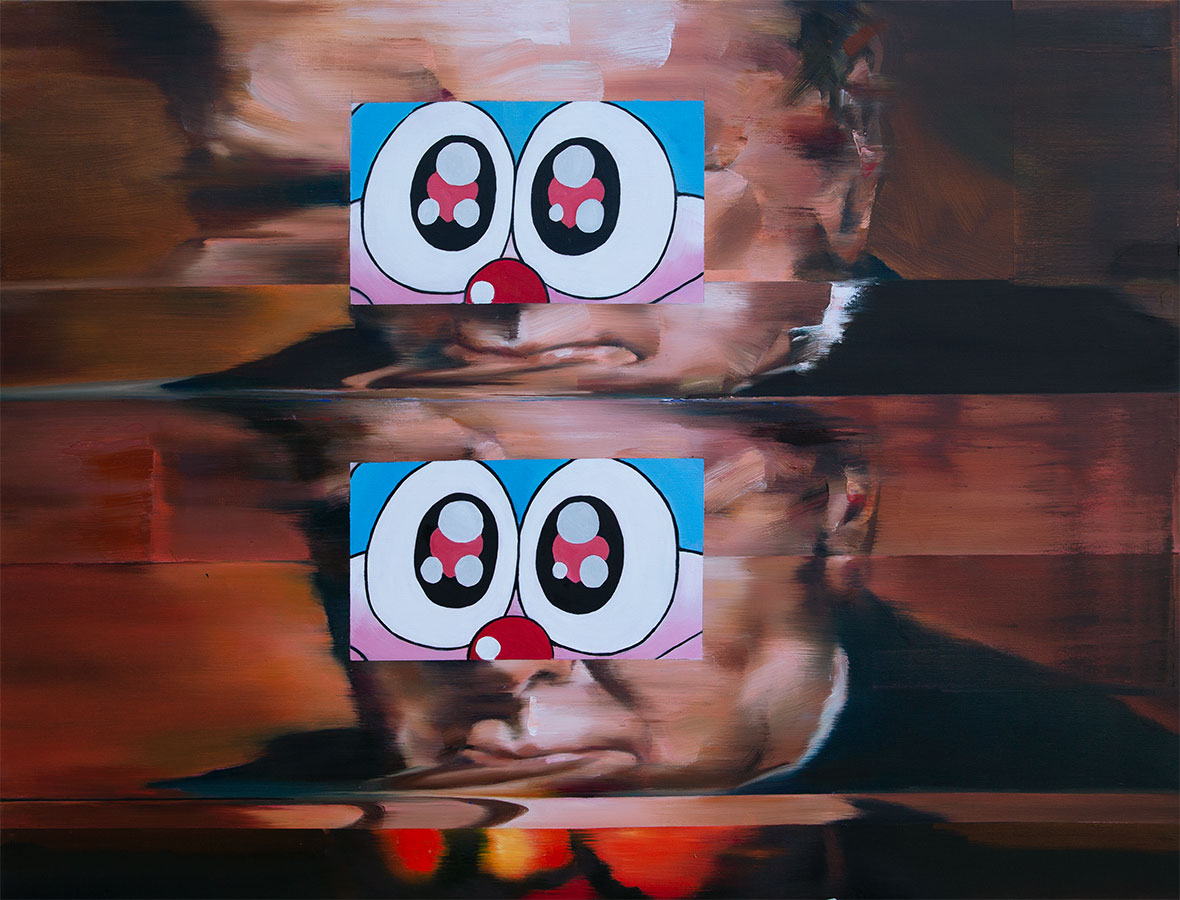
Likewise, Jang believes that growing up between very emotional parents influenced his development as an artist. “My parents would always start fights for silly and trivial reasons. I saw many situations where the fight began from seemingly unimportant factors—like trying to figure out what to eat in a restaurant—and then escalated to discussions about getting divorced,” he remembers.
It’s almost as if the dynamics in his family were a microcosm of the larger scenario he expresses with his work and his helplessness as a child represented our everyday confusion and torpor while facing the status quo. His blurred, pixelated characters convey an unhinged world where “the power that can change the lives of regular people no longer takes a logical form, but rather penetrates their lives in a denser and consumable format,” as he puts it.
Amazingly enough, Jang doesn’t consider his work to be political—at least not intentionally. “I tend to believe that my work is irrelevant. But, since I am often asked this question, it’s likely that I subconsciously pay attention to political tensions. Still, that’s not what I’m talking about directly,” he says, and he adds his paintings are not necessarily critical of the individuals they show. To him, their faces represent something bigger. Just like Warhol’s portraits, Jang’s characters reflect the world we live in—online and offline—and, especially when fused with the lunacy of the internet, they ooze the zeitgeist of our time.
Jang 成长在一个情绪化严重的家庭,他认为成长经历潜移默化地影响了自己的创作。“父母曾总会因为一些愚蠢和微不足道的小事吵得不可开交。”Jang 说道,“我曾多次目睹他们在餐馆等公共场合因小事发生口角,甚至以离婚相逼。”
家庭矛盾几乎可以看作是他作品中更具个人内涵的缩影,童年的无助则反映了人们面对现状时的冷漠与麻木。而他笔下面目模糊的像素化人物展现了一个混乱的世界:在那里,能改变人们生活的权力挣脱了理性的约束。因而,这些权力更进一步渗入并人们的生活,消耗他们的人生。
出人意料的是,Jang 并不认为自己的作品具有政治性,至少他的初衷并非如此。他认为,“我倾向于认为我的作品与政治无关。但人们总是提及这一问题,因此政治矛盾可能存在于我的潜意识里,而这并非重点。”此外,他还认为作品无关指责和批判。对他而言,他们的面孔具有更深刻的内涵。同沃霍尔的作品一样,Jang 笔下的的人物也反映了我们生活的这个世界,无论是网络空间抑或现实生活都得到了体现。毕竟,现实生活掺杂了网络上的痴笑疯癫——这才是这个时代的真实写照。
Like our stories? Follow us on Facebook and Instagram.
Instagram: @jangkamzza
Contributors: Tomas Pinheiro, Lucas Tinoco
Chinese Translation: Alice Zhang
Images Courtesy of UARTSPACE and Jang Seungkeun
Instagram: @jangkamzza
供稿人: Tomas Pinheiro, Lucas Tinoco
英译中: Alice Zhang
图片由 UARTSPACE 与 Jang Seungkeun 提供

